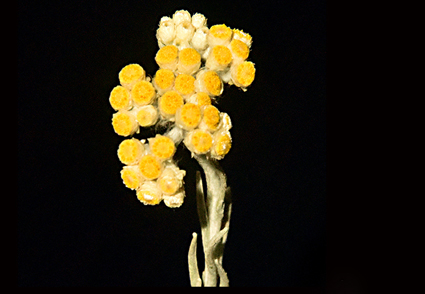Abstract
Anaphalis munnarensis, a new taxon belonging to the family Asteraceae from montane grasslands of Meesapulimala of southern Western Ghats, Kerala, India, is described and illustrated. The new species exhibits some morphological affinities with its allied species Anaphalis meeboldii, but differs in many attributes. A description of the new species along with details on its distribution and ecology, illustration, colour photographs and comparisons with its allied taxa are provided.
References
- Abid, R. & Qaiser, M. (2007) Cypsela morphology of the genus Anaphalis DC. (Gnaphalieae–Asteraceae) from Pakistan. Pakistan Journal of Botany 39: 1897–1906.
- Anderberg, A.A. (1991) Taxonomy and phylogeny of the tribe Gnaphalieae (Asteraceae). Opera Botanica 104: 1–195. https://doi.org/10.1007/BF00937947
- Bayer, R.J., Breitwieser, I., Ward, J. & Puttock, C. (2007) Tribe Gnaphalieae. In: Kadereit, J.W. & Jeffrey, C. (Eds.) The Families and Genera of Vascular Plants, vol. 8. Springer, Berlin, pp. 246–284. https://doi.org/10.1007/978-3-540-31051-8_7
- Candolle, A.P. de (1837) Prodromus systematis naturalis regni vegetabilis, vol. 6. Treuttel & Würtz, Paris, 271 pp. https://doi.org/10.5962/bhl.title.286
- Chen, Y.S., Zhu, S.X. & Bayer, R.A. (2011) Gnaphalieae. In: Wu, Z.Y., Raven, P.H. & Hong, D.Y. (Eds.) Flora of China, vols. 20–21. Science Press, Beijing & Missouri Botanical Garden Press, St. Louis, pp. 774–818.
- Fyson, P.F. (1914) Plantarum Novarum in Horti Regii Conservantum. Decas LXXX. Bulletin of miscellaneous information, vol. 6. Royal Gardens, Kew, pp. 205–210. https://doi.org/10.2307/4119502
- Gamble, J.S. (1921) Flora of the Presidency of Madras, vol. 2. Adlard & Son Ltd., London. 798 pp.
- Hooker, J.D. (1881) The Flora of British India, vol 3. Lovell Reeve and Co., London, UK. 712 pp.
- Lecoq, H. & Juillet, J. (1831) Dictionnaire Raisonne des Termes de Botanique et des Familles Naturelles:contenant l’étymologie et la description détaillée de tous les organes, leur synonymie, et la définition des adjectifs qui servent à les décrire; suivi d’un Vocabulaire des termes grecs et latins les plus généralement employés dans la glossologie botanique. Baillière, 296 pp.
- Lindley, J. (1829) Compositae. In: Loudon, J. (Ed.) An Encyclopaedia of Plants. Longman, Rees, Orme, Brown and Green, London, pp. 1072–1074.
- Kartikeyan, S., Sanjappa, M., Moorthy, S., Bhattacharjee, B., Dash, S.S., Meena, S.L. & Mastakar, V.K. (2020) Asteraceae. In: Mao, A.A. & Dash, S.S. (Eds.) Flowering Plants of India: An Annotated Checklist (Dicotyledons), Vol. 1. Botanical Survey of India, Kolkata, pp. 717–720.
- Narasimhan, D. & Irwin, S.J. (2021) Flowering plants of Tamil Nadu: a compendium. Care Earth Trust, Chennai. 1001 pp.
- Nayar, T.S., Beegam, A.R. & Sibi, M. (2014) Flowering Plants of the Western Ghats, India, vol. 1. Jawaharlal Nehru Tropical Botanic Garden and Research Institute, Palode, 934 pp.
- Nie, Z.L., Funk, V., Sun, H., Deng, T., Meng, Y. & Wen, J. (2013) Molecular phylogeny of Anaphalis (Asteraceae, Gnaphalieae) with biogeographic implications in the Northern Hemisphere. Journal of Plant Research 126: 17–32. https://doi.org/10.1007/s10265-012-0506-6
- Pant, R. (1995) Gnaphalieae. In: Hajra, P.K., Rao, R.R., Singh, D.K. & Uniyal, B.P. (Eds.) Flora of India, vol. 13. Botanical Survey of India, Kolkata, pp. 51–113.
- POWO (2022) Plants of the World Online. Royal Botanic Gardens, Kew. Available from: http://www.plantsoftheworldonline.org/ (accessed: 17 August 2022).
- Sasidharan, N. (2011) Flowering plants of Kerala: CD–ROM ver 2.0. Kerala Forest Research Institute, Peechi, Kerala.
- Singh, P., Karthigeyan, K., Lakshminarasimhan, P. & Dash, S.S. (2015) Endemic Vascular Plants of India. Botanical Survey of India, Kolkata, 339 pp.
- Smith, W.W. (1911) Four new species of the Compositae from South India and a Justicia from Assam. Records of the Botanical Survey of India 4: 283–285.
- Ward, J., Bayer, R.J., Breitwieser, I., Smissen, R., Galbany Casals, M. & Unwin, M. (2009) Gnaphalieae. In: Funk, V.A., Susanna, A., Stuessy, T.F. & Bayer, R.J. (Eds.) Systematics, evolution and biogeography of Compositae. International Association for Plant Taxonomy, Vienna, pp. 539–588.
- Xu, X., Wei, Z., Zhang, T. & Zhu, S.X. (2021) Achene micro-morphology of Anaphalis DC. (Gnaphalieae–Asteraceae) from China. Pakistan Journal of Botany 53 (5): 1883–1892. https://doi.org/10.30848/PJB2021-5(10)


